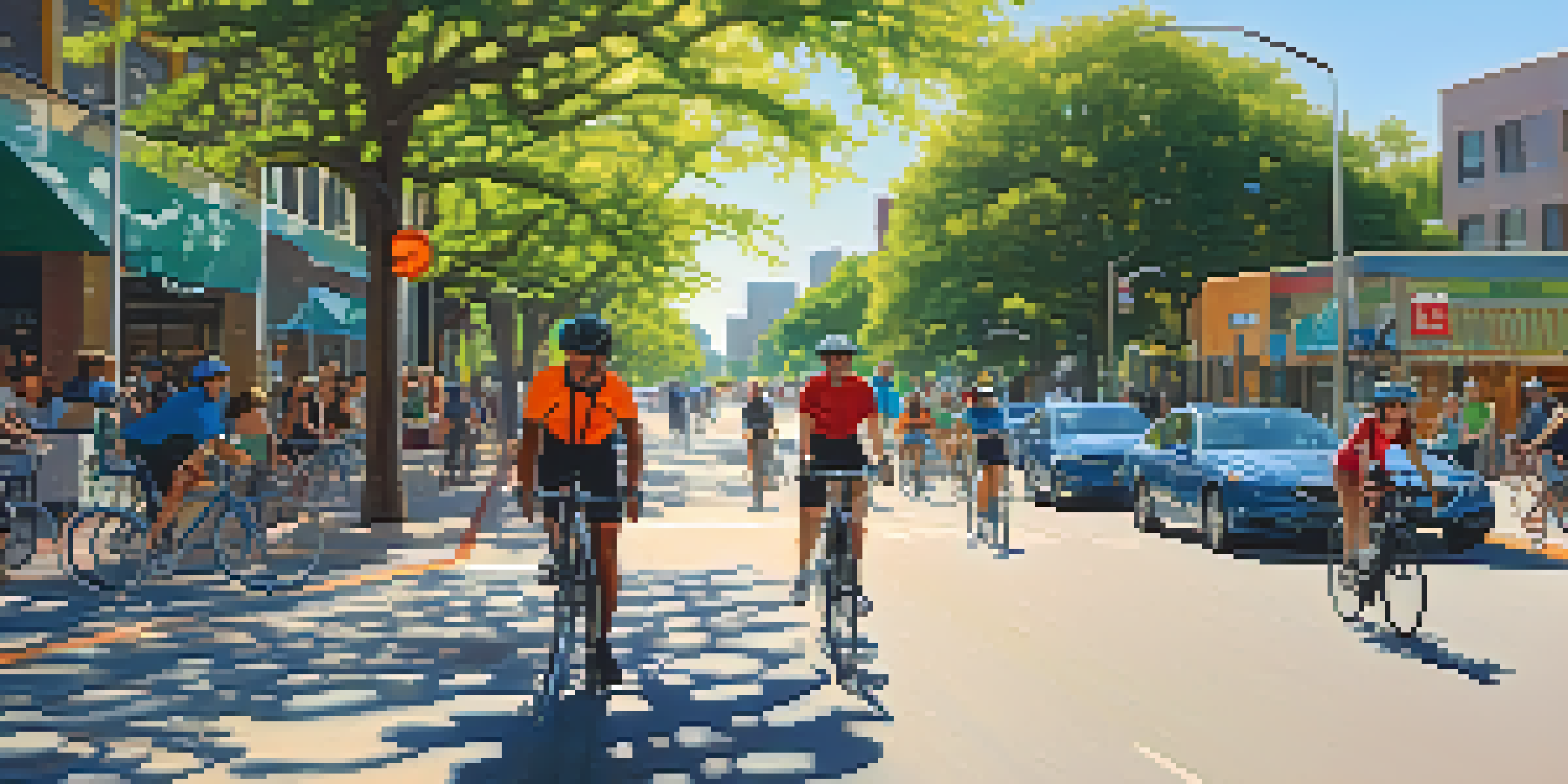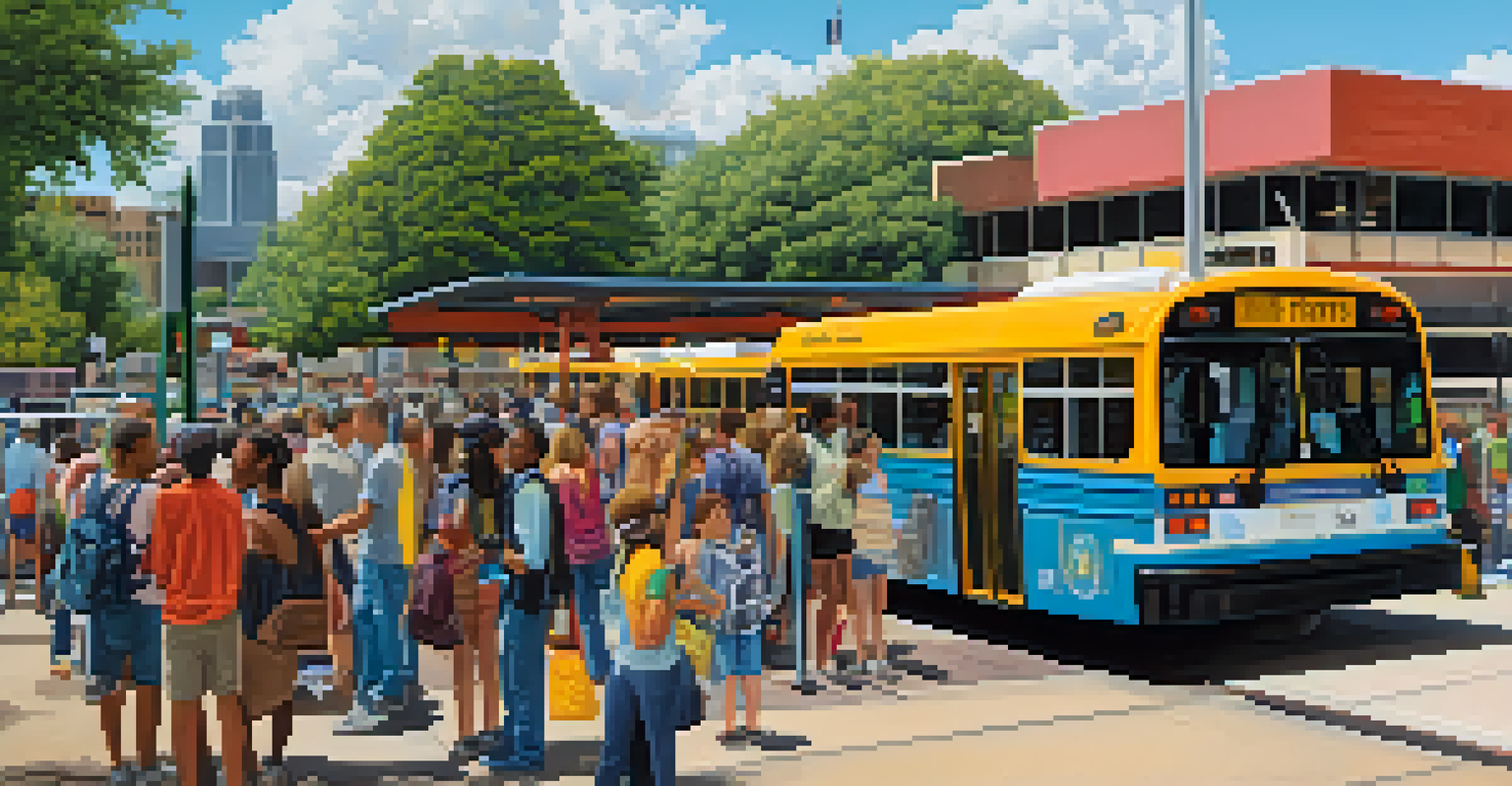Exploring Sustainable Transportation Options in Austin Today

Understanding Sustainable Transportation in Austin
Sustainable transportation refers to modes of travel that are eco-friendly and reduce environmental impact. In Austin, this includes options like biking, public transit, and walking. The goal is to create a cleaner, more efficient way to move around the city while also supporting a healthier lifestyle.
The future will either be green or not at all.
As more cities prioritize sustainability, Austin is stepping up with initiatives that encourage residents to think about their transportation choices. By investing in greener modes of transit, the city aims to reduce traffic congestion and air pollution. This shift not only benefits the environment but also enhances the overall quality of life for its residents.
To truly understand the scope of sustainable transportation in Austin, we must consider the blend of technology and community effort. Local organizations and city planners are working together to create infrastructure that supports these eco-friendly options, making it easier for everyone to participate in this movement.
The Rise of Biking in Austin
Biking has gained immense popularity in Austin, transforming the way many residents navigate the city. With bike lanes expanding and bike-sharing programs like B-Cycle, getting around on two wheels has never been easier. This growth is fueled by a community that values health, sustainability, and convenience.

One of the most significant changes has been the incorporation of dedicated bike lanes, allowing cyclists to travel safely alongside motor vehicles. This infrastructure not only encourages more people to bike but also contributes to reduced traffic congestion. Imagine a city where you can hop on a bike and feel safe riding to work or enjoying a leisurely weekend ride through the park.
Biking is Transforming Austin
The expansion of bike lanes and community programs is making biking a popular and safe transportation option for residents.
Local events, like the annual Austin Bike Tour, celebrate this biking culture and promote it as a viable transportation option. These gatherings foster a sense of community and encourage people to explore their surroundings on two wheels, proving that biking is not just an alternative; it's a fun and engaging way to experience the city.
Public Transit: A Sustainable Option for All
Austin's public transit system, Capital Metro, is a cornerstone of sustainable transportation in the city. Offering bus and rail services, it provides a reliable alternative to driving, helping to alleviate traffic and reduce emissions. Many residents are rediscovering the convenience of public transit as they seek eco-friendly travel options.
Sustainability is not just about the environment; it's about creating a better quality of life for everyone.
Recent upgrades, such as the MetroRapid bus service, have made public transit faster and more efficient. With dedicated bus lanes and real-time tracking, riders can expect a smoother experience. The growth of public transit not only helps the environment but also integrates seamlessly with other sustainable modes of travel, like biking and walking.
Moreover, community initiatives promote public transit use by providing discounts and incentives for riders. The city recognizes that a well-connected transit system encourages more people to leave their cars at home, fostering a culture of sustainability that resonates throughout Austin.
Walking: The Most Accessible Transportation Option
Walking is perhaps the simplest and most accessible form of sustainable transportation. In a city like Austin, where many neighborhoods are designed for walkability, it's easy to see why this option is gaining traction. Residents are embracing walking not just as a means of getting from point A to B but as a way to engage with their community.
The benefits of walking extend beyond just reducing carbon footprints; it's also a fantastic way to stay active and maintain a healthy lifestyle. With numerous parks, trails, and pedestrian-friendly streets, Austin offers ample opportunities for residents to explore their surroundings on foot. Just imagine strolling through the vibrant streets, enjoying the sights and sounds of the city.
Public Transit Enhances Sustainability
Austin's Capital Metro public transit system offers an efficient alternative to driving, reducing traffic and emissions.
Community events, like neighborhood walks and “walk to school” programs, further promote walking as a preferred choice. These initiatives not only enhance social connections but also encourage a culture of sustainability, showing that every step counts toward a greener future.
Carpooling and Ridesharing: A Collective Approach
Carpooling and ridesharing have emerged as popular options for those looking to reduce their environmental impact while commuting. Services like Uber and Lyft, along with local carpool initiatives, make it easy to share rides with others heading in the same direction. This collective approach helps to decrease traffic congestion and lowers the number of vehicles on the road.
In Austin, local organizations are encouraging carpooling through incentives and dedicated carpool lanes. These measures not only make ridesharing more appealing but also foster a sense of camaraderie among commuters. Imagine sharing stories and building connections with fellow riders, all while contributing to a cleaner environment.
As more people embrace these options, the city benefits from reduced emissions and a more efficient transportation system. Carpooling and ridesharing reflect a growing awareness of sustainability and a commitment to improving urban mobility, making them integral to Austin's transportation landscape.
Electric Vehicles: Driving into a Sustainable Future
Electric vehicles (EVs) are revolutionizing the way we think about transportation and sustainability. In Austin, the push for EV adoption is evident, with numerous charging stations popping up across the city. These vehicles produce zero tailpipe emissions, making them an appealing option for eco-conscious drivers looking to make a difference.
The city has also introduced initiatives that support EV use, such as rebates and incentives for purchasing electric cars. These efforts encourage residents to transition from traditional gasoline-powered vehicles to cleaner alternatives. Imagine driving through the city, knowing that your choice is contributing to a healthier environment.
Community Drives Sustainable Change
Active community involvement in transportation planning fosters a culture of sustainability and supports a healthier urban environment.
As more residents opt for electric vehicles, the infrastructure to support them continues to grow. From charging stations to community awareness programs, Austin is paving the way for a future where sustainable transportation is not just an option but the norm.
The Future of Sustainable Transportation in Austin
Looking ahead, the future of sustainable transportation in Austin appears promising. With ongoing investments in infrastructure and technology, the city is committed to creating a transportation network that prioritizes eco-friendly options. Plans for expanded bike lanes, improved public transit, and more pedestrian-friendly spaces are already in the works.
Community engagement plays a crucial role in this vision, as residents are encouraged to voice their opinions and participate in the planning process. By involving the community, Austin ensures that the transportation options reflect the needs and desires of its residents. This collaborative approach fosters a sense of ownership and pride in the city's commitment to sustainability.

Ultimately, the success of sustainable transportation in Austin relies on the collective efforts of its residents, businesses, and government. Together, they can create an environment that not only supports sustainable travel but also champions a healthier, more vibrant community for generations to come.